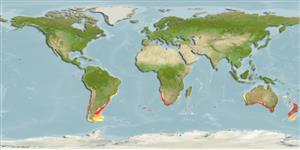Common names from other countries
分類 / Names
共通名の | 類義語 | Catalog of Fishes(部類, 種) | ITIS | CoL | WoRMS | Cloffa
>
Scombriformes (Mackerels) >
Gempylidae (Snake mackerels)
Etymology: Thyrsites: Greek, thyrsites, -ou = stalk of a plant, an ornament like a pine cone borne by Bacchus (Ref. 45335).
Environment: milieu / climate zone / depth range / distribution range
生態学
海; 汽水性の 底生の漂泳性; 海洋回遊性; 深さの範囲 0 - 550 m (Ref. 6390), usually 100 - 500 m (Ref. 6181). Subtropical; 13°C - 18°C (Ref. 6181); 21°S - 56°S, 75°W - 177°E (Ref. 54924)
Southwest Atlantic: Uruguay, Argentina and Tierra del Fuego. Eastern Atlantic: Tristan da Cunha and South Africa. Western Indian Ocean: South Africa and the St. Paul and Amsterdam islands. Eastern Indian Ocean: Tasmania and southern coast of Australia. Southwest Pacific: New Zealand and southern coast of Australia. Southeast Pacific: southern Peru, Chile, and Tierra del Fuego.
Length at first maturity / サイズ / 重さ / 年齢
Maturity: Lm 55.0, range 50 - 60 cm
Max length : 200 cm SL オス/雌雄の選別がない; (Ref. 3630); common length : 75.0 cm SL オス/雌雄の選別がない; (Ref. 6181); 最大公表体重: 6.0 kg (Ref. 6181); 最大記録サイズ: 10 年 (Ref. 28892)
背面の脊椎 (合計): 19 - 21; 背鰭 (合計): 113; 肛門の骨 1; 臀鰭: 10 - 12; 脊つい: 35. Body elongate and strongly compressed. Lateral line single, running close to the upper contour of the body below most of the first dorsal-fin base then abruptly curving ventrally. Body is dark blue, slightly paler on belly; first dorsal fin membrane black (Ref. 6181).
Inhabit continental shelves or around islands. Feed on pelagic crustaceans (Euphausia, Nyctiphanes), cephalopods and fishes (Ref. 6181) like anchovy and pilchard (Ref. 36731). Form schools near the bottom or midwater; sometimes even at the surface at night (Ref. 6181). Prefers temperature between 13° and 18°C (Ref. 36731). Marketed fresh, smoked, canned and frozen; eaten fried, broiled, microwaved and baked (Ref. 9988). Good for fish and chips or smoking; also made into fillet or fish cake in Japan (Ref. 6181). Commonly called as Baracoutta and because it is a fast predator, several English vessels were named after it. In the UK during WW II, this canned fish was commonly eaten that many older people have an aversion to it (D. Parkyn, pers. comm. 05/2022).
Life cycle and mating behavior
成熟 | 繁殖 | 放精 | 卵 | 生産力 | 幼生
Spawning patterns are complex, with different stock spawning at different times of the year (Ref. 6390).
Nakamura, I. and N.V. Parin, 1993. FAO Species Catalogue. Vol. 15. Snake mackerels and cutlassfishes of the world (families Gempylidae and Trichiuridae). An annotated and illustrated catalogue of the snake mackerels, snoeks, escolars, gemfishes, sackfishes, domine, oilfish, cutlassfishes,. scabbardfishes, hairtails, and frostfishes known to date. FAO Fish. Synop. 125(15):136 p. (Ref. 6181)
CITES (Ref. 128078)
Not Evaluated
Human uses
水産業: 高い商業の; ゲームフィッシュ: はい
より多くの情報
協力者画像Stamps, Coins Misc.音シガテラ(食中毒の名前)速度泳ぐ 型式カマOtoliths脳視覚
用具
特記事項
XMLをダウンロードして下さい
インターネットの情報源
Estimates based on models
Preferred temperature (Ref.
115969): 6.2 - 16, mean 11.2 (based on 285 cells).
Phylogenetic diversity index (Ref.
82804): PD
50 = 1.0000 [Uniqueness, from 0.5 = low to 2.0 = high].
Bayesian length-weight: a=0.00427 (0.00237 - 0.00767), b=3.07 (2.90 - 3.24), in cm Total Length, based on LWR estimates for this species & (Sub)family-body (Ref.
93245).
栄養段階 (Ref.
69278): 3.6 ±0.3 se; based on diet studies.
回復力 (Ref.
120179): 手段, 1.4年~4.4年の倍増期間の最小個体群 (tm=2-4; tmax=10).
Prior r = 0.53, 95% CL = 0.35 - 0.80, Based on 3 stock assessments.
Fishing Vulnerability (Ref.
59153): Moderate to high vulnerability (53 of 100).
Climate Vulnerability (Ref.
125649): Moderate vulnerability (43 of 100).
